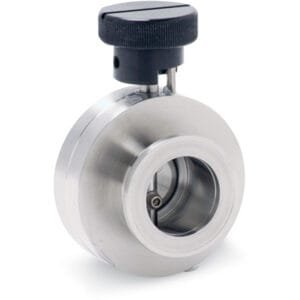Fixed Blank (Blind) 316LN SS Standard ConFlat® (CF) UHV Flanges
Fixed Blank (Blind) 316LN SS Standard ConFlat® (CF) UHV Flanges are designed for use in ultra-high vacuum (UHV) systems where a permanent and secure seal is required for blanking off unused ports or connections. These flanges are made from 316LN stainless steel, known for its corrosion resistance, mechanical strength, and low outgassing properties, making them ideal for UHV environments where maintaining vacuum integrity is crucial.
Key Features
Material: Constructed from 316LN stainless steel, these flanges offer excellent corrosion resistance, superior mechanical strength, and low outgassing, making them perfect for UHV applications. The material ensures long-term durability in high vacuum systems.
Fixed Blank (Blind) Design: The fixed blank design provides a secure, permanent seal for unused ports or openings in vacuum chambers, preventing leaks and ensuring the vacuum integrity is maintained throughout operation.
ConFlat® Seal: Equipped with a ConFlat® (CF) metal-to-metal seal, these flanges provide a reliable, leak-tight connection, essential for high-vacuum and ultra-high vacuum environments.
Standard Dimensions: Manufactured to conform to standard ConFlat® (CF) dimensions, allowing for easy integration with other ConFlat® components and compatibility with various UHV systems.
Durability: The high-quality 316LN stainless steel offers resistance to corrosion, wear, and high temperatures, ensuring these flanges perform reliably over time in UHV conditions.
Precision Engineering: The flanges are precisely engineered for a perfect fit and minimal risk of contamination, providing reliable sealing performance in demanding vacuum applications.
Applications
Ultra-High Vacuum Systems: These flanges are used to seal unused ports or openings in UHV systems, ensuring vacuum integrity and preventing contamination.
Semiconductor Manufacturing: Used in semiconductor fabrication processes, where high vacuum conditions are critical for the precise manufacturing of electronic components and devices.
Research and Development: Ideal for laboratory settings and R&D environments that require blanking off ports or connections without compromising vacuum conditions.
Material Science: Employed in thin-film deposition and other material processing applications, where maintaining a clean and stable vacuum environment is essential.
Electron Microscopy: Commonly used in electron microscopy and other imaging techniques that require high-quality vacuum conditions to produce high-resolution images and reliable data.
Why Choose TFM’s Fixed Blank (Blind) 316LN SS Standard ConFlat® (CF) UHV Flanges?
High-Quality Material: Made from 316LN stainless steel, which provides excellent resistance to corrosion, wear, and high temperatures, ideal for use in UHV systems.
Permanent Seal: The fixed blank design ensures a permanent, secure seal, which is crucial for applications where sealing off a port is necessary.
ConFlat® Seal Technology: The ConFlat® metal-to-metal seal offers exceptional sealing performance, preventing leaks and ensuring the system maintains its vacuum integrity.
Precise Fit: Designed and manufactured with precision to ensure minimal risk of contamination and reliable performance over time.
Versatile Use: These flanges are ideal for a variety of UHV applications, from semiconductor manufacturing to scientific research, ensuring compatibility with other ConFlat® components.
Long-Lasting Performance: The flanges offer durability and reliability, ensuring they perform well over long periods and in demanding environments.
Manufacturing Process
Cold Pressing and Sintering: The flange is made using cold pressing and sintering techniques, ensuring uniformity and high density.
Elastomer Bonding: The flange is elastomer-bonded to a backing plate for enhanced durability, especially in high-temperature or high-vacuum conditions.
Cleaning: Each flange is thoroughly cleaned to remove contaminants that could affect the vacuum performance, ensuring they are ready for use in precision applications.
Packaging: After cleaning, the flanges are carefully packaged to protect them from damage and contamination during transport, ensuring they arrive in perfect condition.
Ordering Table
| Flange Size/OD | Type | Flange Material | Part Number |
| Fixed | 316LN SS | 316LN SS | F0133N000NLN |
| Fixed | 316LN SS | 316LN SS | F0212N000NLN |
| Fixed | 316LN SS | 316LN SS | F0275N000NLN |
| Fixed | 316LN SS | 316LN SS | F0337N000NLN |
| Fixed | 316LN SS | 316LN SS | F0450N000NLN |
| Fixed | 316LN SS | 316LN SS | F0600N000NLN |
| Fixed | 316LN SS | 316LN SS | F0675N000NLN |
| Fixed | 316LN SS | 316LN SS | F0800N000NLN |
| Fixed | 316LN SS | 316LN SS | F1000N000NLN |
| Fixed | 316LN SS | 316LN SS | F1200N000NLN |
| Fixed | 316LN SS | 316LN SS | F1325N000NLN |
| Fixed | 316LN SS | 316LN SS | F1400N000NLN |





Reviews
There are no reviews yet.